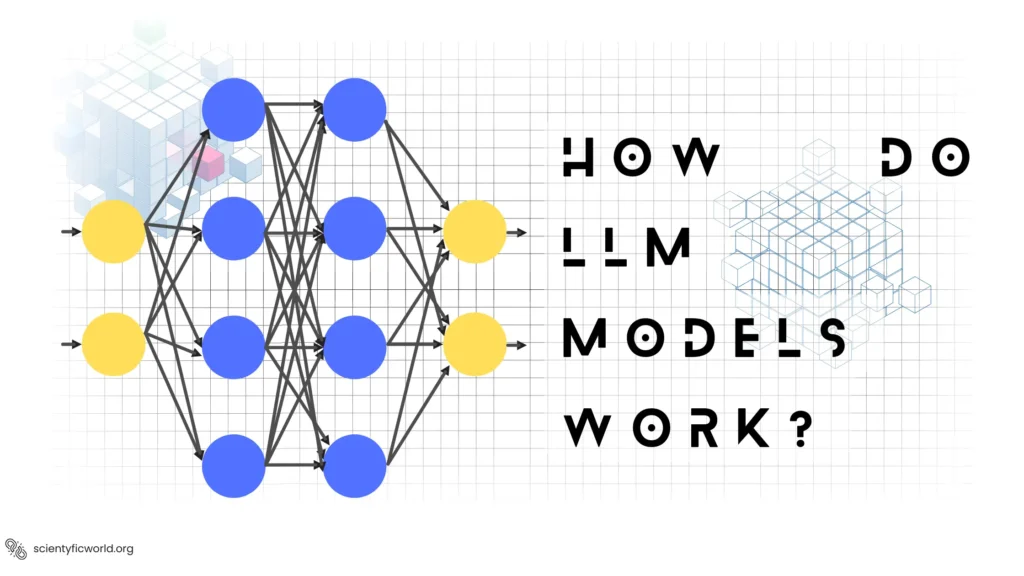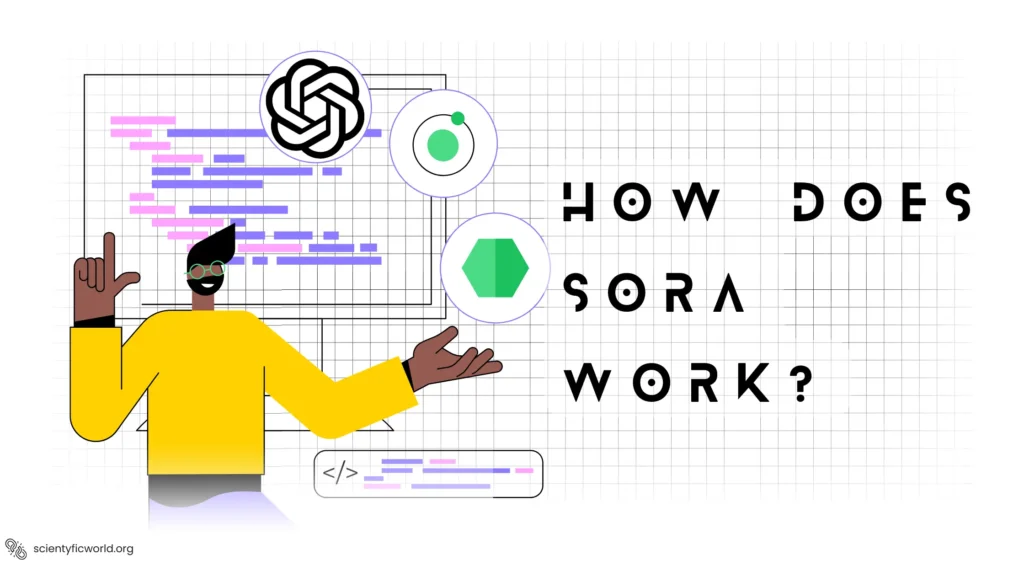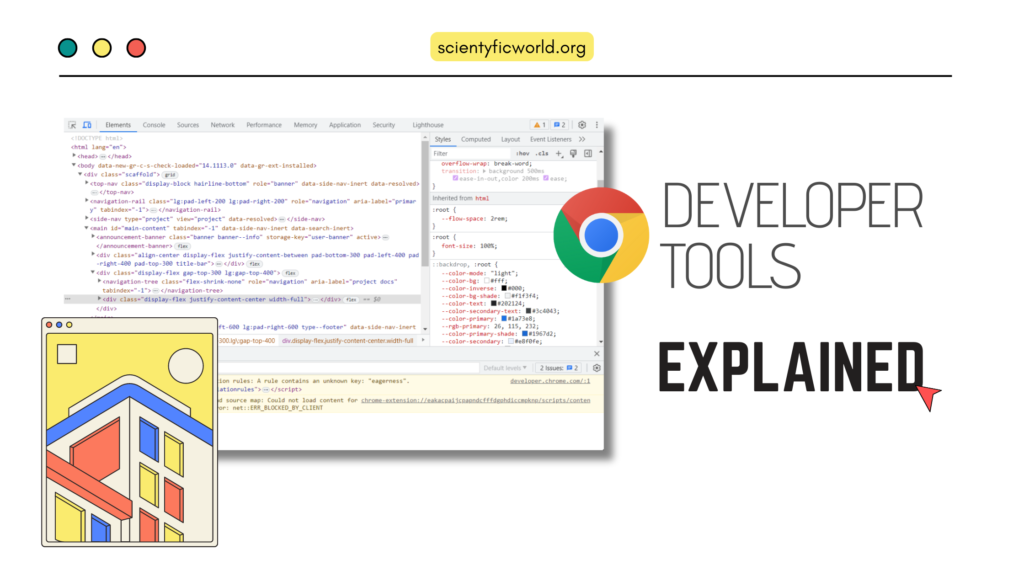Follow Us:
A Critical Analysis of Google’s Gemini Model: Hype or Hope?
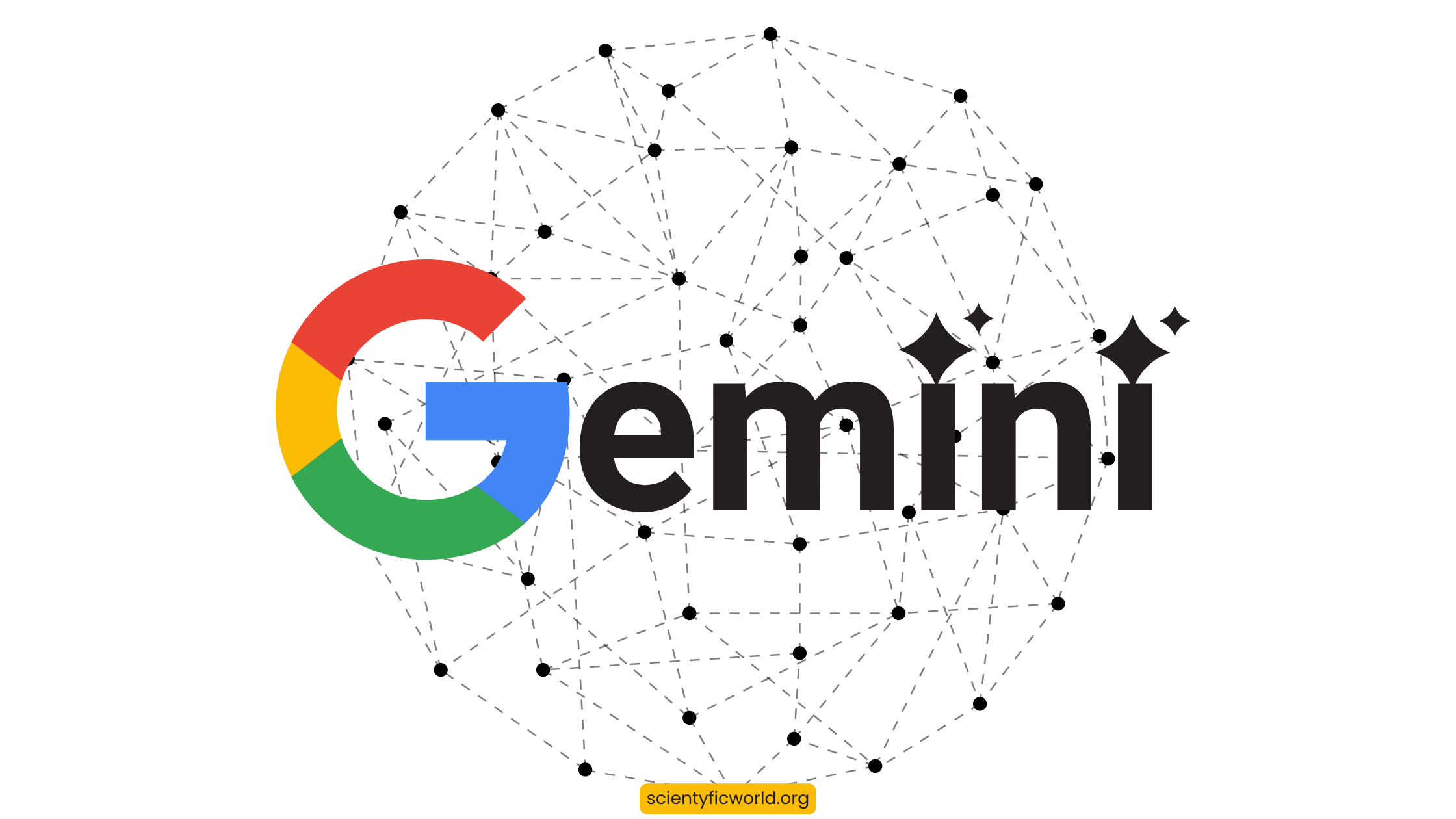
Google’s recent launch of the Gemini model, a massive multi-modal language model (MMLLU), has sent shockwaves through the AI community. Touted as the most advanced AI model ever created, Gemini promises to revolutionize the way we interact with computers, generate text, translate languages, and solve complex problems. However, amidst the excitement and hype, it’s crucial to critically analyze Gemini’s potential impact on the broader AI landscape, considering not only its transformative capabilities but also its ethical implications and potential risks.
While initial reports highlight Gemini’s impressive performance on benchmarks like MMLU, exceeding even human experts, it’s essential to delve deeper than mere numbers. We need to dissect Gemini’s architecture, understanding its underlying mechanisms like multimodal learning and the Transformer-based encoder-decoder structure. Only then can we truly grasp the model’s strengths and limitations, identifying its potential for creative applications as well as its susceptibility to bias and manipulation?
Furthermore, exploring Gemini’s impact necessitates examining its downstream effects. Will its deployment lead to job displacement in specific sectors? Will its decision-making processes be transparent and explainable, or will they remain shrouded in a black box of algorithms? Can we ensure that its development and use adhere to ethical principles and avoid exacerbating existing societal inequalities?
This blog aims to move beyond the initial hype and hype surrounding Gemini. We’ll critically examine its potential impact on the AI landscape, dissecting its capabilities, explore its ethical considerations, and navigating the future of AI with this powerful technology at the helm. Through this analysis, we hope to foster a nuanced understanding of Gemini’s influence and encourage responsible and equitable development of AI for the benefit of humanity.
What is Google’s Gemini AI?
Google’s Gemini AI is a highly advanced, multimodal language model developed by Google DeepMind. It’s designed to process and understand various types of data, including text, images, and audio. Gemini is notable for its Transformer-based architecture, enabling efficient processing and handling of long-range dependencies in data. It’s positioned to revolutionize tasks like text generation, language translation, and complex problem-solving. The model’s multimodal capabilities and potential applications span across industries like healthcare, finance, education, and entertainment, making it a significant development in the AI field.
For a detailed understanding, refer to Google’s official blog post.
Types of Gemini Model:
The three types of Google’s Gemini AI model are designed for different purposes and performance levels:
- Gemini Ultra: This is the largest and most capable model, designed for highly complex tasks. It offers the highest performance in terms of processing and understanding diverse, intricate datasets.
- Gemini Pro: Aimed at scalability, Gemini Pro is versatile, balancing performance with efficiency. It’s tailored for a wide range of tasks, making it suitable for diverse applications.
- Gemini Nano: This model is optimized for efficiency, particularly for on-device tasks. It’s the most streamlined version, designed to work in environments where resources are limited, like mobile devices.
Key Strengths of the model:
At its core, Gemini boasts several key strengths:
- Multimodal Learning for Holistic Information Processing: At the core of Gemini’s capabilities lies its innovative approach to multimodal learning. This groundbreaking technique enables the model to seamlessly process and understand a diverse range of information modalities, including:
- Text: Analyzing and generating text in various formats, from factual summaries and technical documents to creative writing and poetry.
- Code: Understanding and generating code across multiple programming languages, assisting in software development and automation.
- Images: Recognizing and interpreting visual information, enabling applications like image captioning, object detection, and scene understanding.
- Audio: Analyzing and synthesizing audio signals, leading to advancements in speech recognition, audio generation, and music composition.
This unique ability empowers Gemini to tackle complex tasks that require integrating and analyzing information from various sources simultaneously. For example, it can analyze a research paper, translate its text into another language, summarize key findings, and generate a presentation with relevant images and audio narration. This remarkable versatility opens up a vast landscape of potential applications across diverse industries.
- Transformer-Based Architecture for Enhanced Efficiency and Long-Range Dependencies: Gemini further leverages the power of Transformers, a deep-learning architecture revolutionizing the field of natural language processing. Transformers excel at capturing long-range dependencies within sequences, leading to:
- Improved context awareness: Gemini can effectively understand the broader context of the information it processes, resulting in more accurate and nuanced outputs.
- Enhanced handling of complex relationships: The model can analyze complex relationships between different data modalities, enabling it to generate more cohesive and meaningful outputs.
- Greater efficiency and scalability: Transformer architecture allows for efficient training and inference, enabling Gemini to handle large and complex tasks with minimal computational resources.
This combination of multimodal learning and Transformer-based architecture empowers Gemini to operate at a level far exceeding previous models. Its ability to process information holistically from multiple sources positions it as a game-changer across various domains.
- Diverse Capabilities for Transforming Industries: The potential applications of Gemini are vast and far-reaching, with the potential to transform numerous industries:
- Healthcare: Analyzing medical data, assisting in diagnosis and treatment planning, developing personalized healthcare solutions, and facilitating communication between healthcare professionals and patients.
- Finance: Predicting market trends, generating personalized financial recommendations, automating financial transactions, and enhancing risk management strategies.
- Education: Creating personalized learning experiences, providing adaptive learning support, grading essays and exams, and developing new educational content.
- Entertainment: Generating personalized content recommendations, designing immersive gaming experiences, creating interactive storytelling formats, and composing original music or soundtracks.
- Science and Research: Analyzing scientific data, accelerating research breakthroughs, generating new scientific hypotheses, and facilitating collaboration between researchers.
By automating complex tasks, assisting humans in decision-making, and unlocking new avenues for creativity and innovation, Gemini has the potential to revolutionize the way we work, learn, and interact with the world around us.
- A Glimpse into Future Applications: As Gemini’s development continues, its capabilities will likely expand further, leading to even more transformative applications:
- General-purpose AI: Gemini may evolve into a truly general-purpose AI capable of reasoning, problem-solving, and adapting to new situations.
- Human-AI collaboration: Gemini could become a powerful partner for humans, assisting them in complex tasks and enhancing human capabilities.
- New forms of creativity: Gemini could unlock unprecedented levels of creativity, leading to advancements in art, music, literature, and other creative fields.
While these future applications remain in the realm of speculation, they highlight the immense potential of Gemini and its ability to shape the future of AI and its impact on our lives.
With such groundbreaking capabilities, it’s essential to acknowledge the potential for unforeseen applications, both beneficial and detrimental. Ethical considerations surrounding bias, transparency, and accountability need careful attention to ensure the responsible development and deployment of Gemini.
Gemini vs GPT4: An In-Depth Comparison
As we continue exploring the world of AI in our blog, we’ve already discussed Gemini in detail. Now, let’s compare it with another big player in the field, GPT-4. Both Gemini and GPT-4 are important in the AI world, especially when it comes to understanding and processing language. In this section, we’re going to look at how Gemini stacks up against GPT-4. We’ll keep things simple and clear, focusing on what makes each model unique, their strengths, and where they might fall short. This is especially useful for developers. We’ll also look at how they handle specific tasks, like helping with coding, to give you a real sense of what they can do.
As we’ve already explored, Gemini is a state-of-the-art AI model known for its advanced capabilities in specific domains. It’s designed to excel in tasks that require deep domain knowledge and contextual understanding.
Whereas GPT-4 was developed by OpenAI, GPT-4 is the latest iteration in the Generative Pre-trained Transformer series. It’s renowned for its broad knowledge base, linguistic versatility, and adaptability across various tasks.
Now, let’s compare these two models.
| Feature/Aspect | Gemini | GPT-4 |
|---|---|---|
| Knowledge Base | Specialized in certain domains, offering in-depth insights. | Extensive and general, covering a wide range of topics. |
| Learning Approach | Focused on deep learning within specific domains. | Utilizes unsupervised learning with a diverse dataset. |
| Language Understanding | Highly contextual in its specialized fields. | Broad and nuanced understanding across multiple languages. |
| Coding Assistance | Potentially more adept in specific programming languages or frameworks. | Versatile in offering coding assistance across various languages and frameworks. |
| Customization | May offer more tailored solutions in certain domains. | General-purpose with adaptable frameworks for different tasks. |
| Real-time Learning | Could be more focused on real-time updates in its areas of expertise. | A broad range of tools and extensive community support. |
| Interactivity | Possibly more interactive in niche scenarios. | Highly interactive with a wide range of conversational abilities. |
| Error Rate | Potentially lower in specialized tasks. | Generally low, but can vary depending on the task complexity. |
| Developer Tools and Support | Specific tools tailored to specialized domains. | Broad range of tools and extensive community support. |
| Use Case Specificity | High in its areas of expertise. | Broad and adaptable to numerous use cases. |
To get a more visual and comparative analysis between Gemini and GPT-4 across various use cases, we can use a graph comparison. This graph has compared their performance in different scenarios relevant to developers, such as coding assistance, language support, debugging capabilities, API integration, and more.
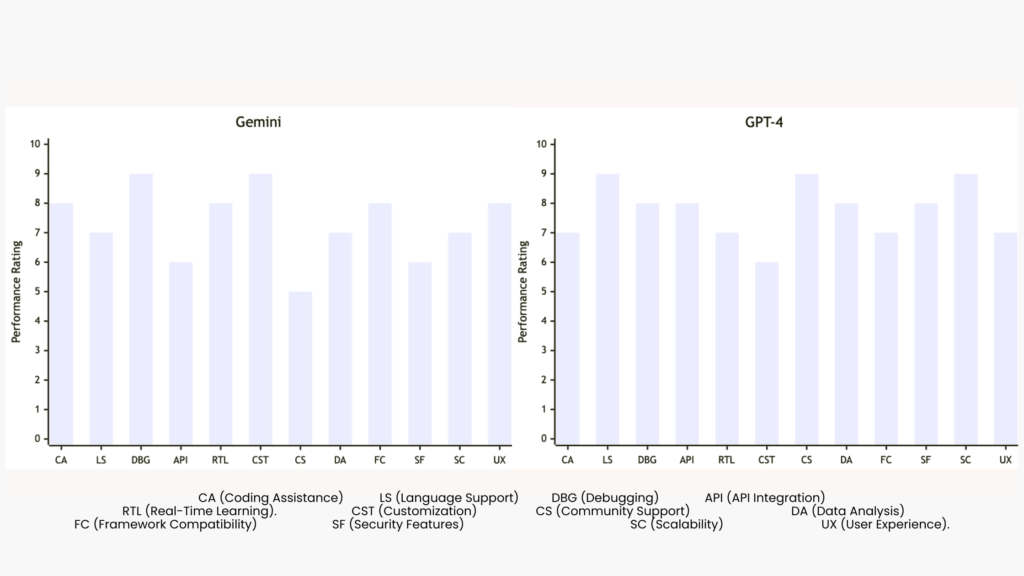
Gemini:
Strengths: If Gemini is specialized in a particular programming language or framework, it could provide more nuanced and in-depth assistance, such as suggesting best practices, identifying subtle bugs, or offering optimization tips specific to that technology.
Limitations: Its effectiveness might be limited outside its area of specialization, potentially offering less assistance with general programming queries or languages it’s not tailored for.
GPT-4:
- Strengths: Known for its versatility, GPT-4 can assist with a wide range of programming languages and frameworks. It can generate code snippets, debug, and provide solutions to common programming problems across various technologies.
- Limitations: While highly versatile, GPT-4 might lack the depth of understanding in specific programming niches compared to a specialized model like Gemini.
Both Gemini and GPT-4 stand out in their respective areas. Gemini excels in specialized domains, offering in-depth knowledge and tailored solutions, making it potentially more suitable for niche applications. On the other hand, GPT-4’s strength lies in its versatility and broad knowledge base, making it ideal for a wide range of applications, including general coding assistance.
For developers, the choice between Gemini and GPT-4 would largely depend on the specific requirements of their project. If the project demands deep expertise in a particular domain, Gemini might be the preferred choice. However, for more general purposes and a broader range of tasks, GPT-4 would likely be more beneficial.
Navigating the Future Landscape of AI with Gemini
The arrival of Gemini marks a pivotal point in the evolution of AI, prompting us to contemplate the future landscape with both excitement and cautious optimism. While its capabilities promise groundbreaking advancements across diverse fields, we must acknowledge the potential challenges and ethical considerations associated with such powerful technology.
- Collaboration and Partnerships: The development and deployment of AI models like Gemini require extensive resources and expertise. This necessitates collaboration and partnerships between tech giants like Google, research institutions, and industry leaders. By pooling resources and knowledge, these collaborations can accelerate the responsible development and deployment of AI for the benefit of society.
- Increased Investment in AI Research and Development: Gemini’s success is likely to spark a surge in investment in AI research and development, leading to the creation of even more advanced AI models. This increased funding will facilitate the exploration of new frontiers in AI, paving the way for technological breakthroughs and discoveries that were once unimaginable.
- Faster Development and Deployment of New AI Models: The speed and efficiency with which Gemini was developed demonstrate the rapid progress being made in AI. This rapid development cycle can be expected to continue, leading to a faster turnover of new AI models, each with its unique capabilities and applications.
- Governance and Regulations: As AI becomes increasingly integrated into our lives, the need for robust governance and regulations becomes paramount. We need to establish ethical frameworks and guidelines for AI development and deployment to ensure transparency, accountability, and fairness. This will involve close collaboration between governments, industry leaders, and civil society to ensure responsible use of AI.
- Human Oversight and Control: While AI models like Gemini possess impressive capabilities, it’s crucial to remember that they are tools designed to be used by humans. We must maintain human control over AI decision-making processes and ensure that AI remains aligned with human values and ethical principles. This necessitates continuous monitoring, evaluation, and refinement of AI models to minimize potential risks and biases.
- Reskilling and Upskilling Workforce: The increasing automation brought about by AI will undoubtedly lead to job displacement in certain sectors. However, it also presents opportunities for reskilling and upskilling the workforce, allowing individuals to adapt to the changing technological landscape. Governments and educational institutions need to play a crucial role in providing retraining programs and resources to ensure a smooth transition for individuals impacted by automation.
- Addressing Algorithmic Bias: One of the most significant challenges facing AI is the potential for algorithmic bias. Training data sets used to develop AI models can reflect existing societal biases, leading to discriminatory outputs. We need to develop techniques for mitigating bias in training data and algorithms to ensure fairness and inclusivity in AI applications.
- Transparency and Explainability: For AI to gain widespread trust and acceptance, it’s essential to ensure transparency and explainability in its decision-making processes. This means developing techniques for understanding how AI models arrive at their outputs and making them interpretable by humans.
- Public Engagement and Education: As AI continues to evolve, it’s crucial to engage the public in discussions about its development and deployment.Educating the public about AI capabilities and limitations is essential for fostering understanding, trust, and responsible use of this powerful technology.
- International Cooperation: The challenges and opportunities presented by AI transcend national borders. We need international cooperation to ensure responsible development and deployment of AI, addressing issues like data privacy, security, and ethics on a global scale.
The future of AI with Gemini on the horizon is brimming with both potential and challenges. By navigating the landscape with foresight, collaboration, and a commitment to ethical development, we can harness the power of AI for the betterment of humanity. We must remember that AI is a tool, and it’s up to us to use it responsibly and thoughtfully to create a future where technology serves us all.
Conclusion:
The emergence of Gemini marks a turning point in the evolution of AI, ushering in a future filled with both exciting possibilities and significant challenges. To ensure this future benefits all of humanity, we must embrace collaboration and responsibility.
Collaboration between tech giants, research institutions, and industry leaders will be crucial in accelerating responsible AI development and deployment. Increased investment in AI research, coupled with robust governance and regulations, will ensure ethical and equitable applications of this powerful technology.
Human oversight and control remain paramount. Reskilling and upskilling the workforce will be essential for navigating the changing technological landscape. Addressing algorithmic bias and fostering transparency are key to building trust and ensuring fairness. Public engagement and international cooperation will be crucial in shaping a future where AI serves humanity as a force for good.
The journey ahead necessitates a commitment to collaboration, ethical considerations, and responsible development. By embracing these principles, we can harness the unparalleled potential of Gemini and other advanced AI models to create a brighter future for all.
FAQs:
When will Google Gemini be available to the public?
While there is no official release date for a publicly accessible version of Google Gemini, it is currently available in beta through Google AI Studio, a free web-based developer tool. This limited access allows developers to experiment with Gemini’s capabilities and provide valuable feedback to Google for further development.
How does Gemini perform compared to GPT-4?
In terms of performance, Gemini has demonstrated strong results, especially in the Massive Multitask Language Understanding (MMLU) benchmark, slightly outperforming GPT-4. For instance, on text-only questions, Gemini scores 90% while GPT-4 scores 86%. On multimodal questions, Gemini scores 59% against GPT-4’s 57%. However, experts suggest that while Gemini’s benchmark scores are impressive, it’s challenging to interpret these numbers fully without transparency about the training data and methodologies.
What are some potential applications of Google Gemini in different industries?
Google Gemini’s capabilities have the potential to transform various industries, including:
1. Healthcare: Analyzing medical images, assisting in diagnosis and personalized treatment planning, and developing new drug discovery strategies.
2. Finance: Predicting market trends, generating personalized financial recommendations, and automating complex financial transactions.
3. Education: Creating personalized learning experiences, providing adaptive learning support, and grading essays and exams objectively and efficiently.
4. Entertainment: Generating personalized content recommendations, designing immersive gaming experiences, and creating interactive storytelling formats.
5. Science and Research: Analyzing scientific data, accelerating research breakthroughs, and generating new scientific hypotheses for further exploration.
Are there any ethical concerns surrounding the development and deployment of Google Gemini?
As with any powerful technology, ethical considerations are paramount when it comes to Google Gemini. Concerns include:
1. Bias: Training data used to develop AI models can reflect existing societal biases, leading to discriminatory outputs. It’s crucial to mitigate bias in training data and algorithms to ensure fairness and inclusivity.
2. Transparency and Explainability: Understanding how AI models arrive at their decisions is essential for building trust and accountability. Techniques for making AI decision-making processes interpretable by humans are crucial.
3. Job displacement: The automation potential of AI models like Gemini raises concerns about job displacement in certain sectors. Reskilling and upskilling programs are necessary to support individuals impacted by automation.
What are the different versions of Gemini and their purposes?
Gemini comes in three different “sizes” – Gemini Ultra, Gemini Pro, and Gemini Nano. Gemini Ultra is the largest and most capable model, designed for highly complex tasks. Gemini Pro is optimized for scaling across a wide range of tasks and is currently used in Bard, Google’s chatbot. Gemini Nano is the most efficient model, suited for on-device tasks such as those in mobile devices like the Pixel 8.
By staying informed and actively engaging with these resources, you can stay ahead of the curve and explore the exciting possibilities that Google Gemini presents for the future of AI.

